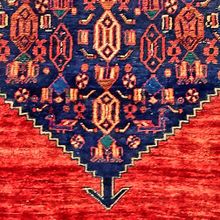Songhor Rug
| Songhor Rug | |
|---|---|
 Design of Songhor Rug (Rugman) | |
| General information | |
| Name | Songhor Rug |
| Original name | قالی سنقر |
| Alternative name(s) | Songhor Carpet |
| Origin | |
| Category | Village |
| Technical information | |
| Common designs | Geometric |
| Common colors | Red, Blue, Camel, Gray |
| Dyeing method | Natural, Synthetic |
| Pile material | Wool |
| Foundation material | Cotton |
| Knot type | Symmetrical (Turkish) |
Songhor is a small village in western Iran at the heart of Kurdistan. The region sits high on the rugged mountains of Persia and life here can be very harsh. The semi-nomadic tribes men and women who weave these rugs, do so in an attempt to follow a tradition of textile art that has been part of their culture for thousands of years. The rugs made in and around Songhor all have similarities in design and quality to most other Kurdish rugs. The colors are bright yet earthy, and the designs are simple and geometric, yet fun and exciting. The quality in these rugs is fairly good and the sizes are usually around five by eight feet. The main colors include taupe, camel, red, and navy blue. These rugs are very special to their weavers and they always bring a special warmth to their new homes.
History
Songhor is a town in the Kermanshah Province located near the border of the Hamadan Province in western Iran. The population in Songhor and in the surrounding area is mostly made up of Kurd and Azeri tribes. The rugs are known in the antique market from the late nineteenth century.
Songhor rugs have either a wool or cotton foundation and a medium to long wool pile. The Turkish (symmetric) knot is always used. Azeri weavers made traditional village rugs with a medallion or allover design. The field and border motifs are mostly geo-metric, with flower heads, leaves, vines, large palmettes, tribal ornaments, and, at times, animals and birds. The Herati (fish) pattern is also used in the medallion and corners of some Songhor rugs. These weavings are categorized as one of the Hamadan Mosul Rugs. Mosuls were marketed successfully worldwide as an inexpensive alternative to Caucasian and Anatolian (Turkish) rugs.
Another rug type woven in Songhor is the Kurdish-made Kolyai with geometric, tribal designs. Kolyai rugs have mostly an allover style but on occasion feature a medallion. The field designs include the Boteh (paisley), Harshang (crab) palmettes, Herati, Minakhani (rosette-linked trellis), flower head, leaves, vines, tribal ornaments, animals, birds, and human figures.
Dark blues or reds are employed for the fields in both types of Songhor rugs, whereas different shades of red, blue, ivory, brown, gold, gray, and green appear in the borders and design elements.
Songhor formats range from small bag faces to rugs approximately seven feet by four feet six inches. Runners up to twelve feet were produced and can be found in the antique trade. Kolyai formats range from small bag faces to carpets approximately twenty-two feet by eight feet. In general, Kolyai dozar (the Farsi word indicating a size of approximately six feet by four feet) rugs are made two to three feet longer than other dozar weavings in Iran. Songhor weavings are generally good to very good in grade quality.
By the last quarter of the twentieth century, the weavers switched from traditional designs and made rugs and carpets similar to those of other areas to meet domestic and foreign export consumer demand.[1]
See also
| Search for Songhor Rug on Wikipedia. |
References
- ↑ Moheban, 2015, 543-544
Bibliography
- Abraham Levi Moheban. 2015. The Encyclopedia of Antique Carpets: Twenty-Five Centuries of Weaving. NewYork: Princeton Architectural Press.